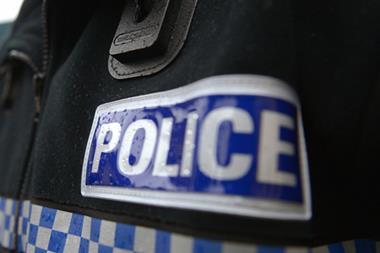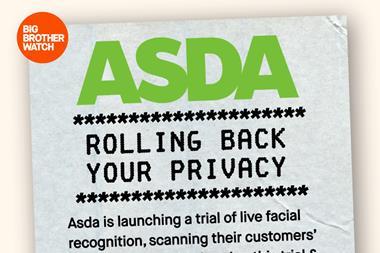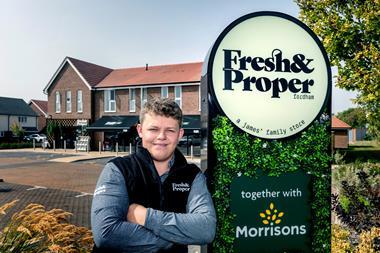Shoplifting is on the up, with the squeezed middle as well as ‘crime tourists’ now getting in on the act. What can be done to tackle the problem, asks Simon Creasey
Spot the shoplifter. Is it the mother of two pushing a pram down the babyfood aisle? Is it the suited and booted gentleman who’s just pulled up in a Mercedes? Is it the hoodie hanging around by the DVDs? Or is it the member of staff stacking cheese into the chiller?
The surprising answer is that it could be any of the above. The 11th edition of Checkpoint Systems’ annual Global Retail Theft Barometer (GRTB) reveals that having dipped last year, UK shrinkage rose 6.2% to £4.9bn in the year to June the highest level in Europe thanks to an increase in shoplifting, higher levels of employee fraud and the rise of organised retail crime gangs indulging in what are delightfully dubbed ‘shoplifting holidays’.
Those involved are not just your common or garden thieves targeting big ticket items such as razors, spirits and pricey cuts of meat, however. They also include people who in a bid to maintain lifestyles they can no longer afford are resorting to stealing everyday items such as cheese, which now has the highest shrink rate of any grocery product (with a whopping 3.9% of all retail sales now lost to shrinkage see right).
The situation has become so serious that for the second successive year, UK retailers increased their spend on loss prevention and security from £998m in 2010 to £1.02bn in 2011. But with ‘criminals’ from the squeezed middle now swelling the shoplifters’ ranks, the industry is going to have to do more than simply throw money at the problem. It is going to have to rethink its tactics.
The harsh fact is that retail crime is set to get worse. Although the shrinkage figures cited in the report aren’t solely the result of crime the theft barometer also measures internal error and mistakes made by suppliers and vendors shoplifters now account for a whopping 43.8% of shrinkage in the UK, followed closely by theft by employees at 36.1%.
The picture could be even bleaker than these figures suggest. The BRC’s Annual Retail Crime Survey in January stated that only 12% of recorded offences are reported to the police, with as many as two million thefts taking place each year, many of which go unpunished.
“It’s a global phenomenon,” says Professor Joshua Bamfield, director of the Centre of Retail Research in Nottingham and author of the GRTB. “More people are stealing and they are stealing more. The problems with the economy, society, politicians and the banking industry have led many people to say ‘it’s alright to steal. I’ve got to look after myself because everybody else is looking after themselves’.”
The socio-demographic make-up of this new breed of shoplifter makes detection difficult, says Checkpoint Systems’ sales and marketing director Russell Holland. It’s no longer just the hard up that are shoplifting, he adds. “You might have a good income and lifestyle and want to maintain it,” he says. “There is no typical shoplifter any more. It’s a broad profile across age, ethnic group, gender and income bands and one finding of the report is it’s getting broader and broader all the time.”
The fact that many items targeted are low-ticket goods not usually fitted with security tags, such as cheese and health & beauty items like mascara makes detection harder still. “Cheese is an everyday item you can hide easily,” he explains. “The huge shrink movement towards mascara is because they’re small and easy to steal and they free up expenditure for other items.”
Some retailers are finally waking up to the growing appeal of such items and are placing security tags on cheese and even bars of chocolate. Others are going further. As The Grocer reveals on page 8, Tesco is launching a crackdown on the thieves that its group security director Alan Brown claims will mark the end of a “one-size-fits-all” approach to store crime.
In the next few weeks, the retailer will kick off a UK trial of software already used in Tesco’s Turkish and Malaysian operations that allows it to analyse incidents on a store by store basis and tailor its strategy accordingly. If a particular store is having lots of cheese stolen, it can put an extra guard on the cheese counter or tag the Stilton, for instance.
“It’s about understanding the risks in your stores,” says Brown. “It’s not necessarily about having more guards in the front of the store. It’s about looking at the total security of a store and making sure everyone there knows what the risks are and how they can be managed.”
It’s also about targeting the different types of criminal involved more effectively. Another major issue highlighted in this year’s GRTB is the rise of organised retail crime. Historically, this has been mainly an American problem, but it’s starting to spread, with 41.7% of European retailers reporting an increase in organised crime in 2011.
One of the reasons the supermarkets are increasingly being targeted is that they now stock a greater number of higher-end non-food items than they used to. Organised gangs are a growing problem, confirms Brown. “We have organised teams trying to move from store to store,” he says. “The vast majority of organised criminals aren’t interested in stealing groceries because there’s no resale value. That’s why we tend to suffer around high value goods such as mobile phones.”
The appeal of retail theft to crime gangs is two-fold: it’s highly profitable and the risks involved are perceived to be low compared with other illegal activities. Hence the rise in what criminologists have described as ‘shoplifting holidays’, with gangs from as far afield as Latin America or Eastern Europe visiting large UK cities with the sole intention of stealing.
“Places like Oxford Street, and large shopping malls in London, York, Edinburgh, Glasgow, Manchester and Cheltenham suffer from international shoplifting gangs who come across for holidays to steal,” says Professor Bamfield. “And it’s not just the UK. European cities like Paris, Cologne and Frankfurt all suffer from it.”
Professor Bamfield has also identified an increase in the number of home-grown shoplifters targeting retailers in neighbouring counties or even further afield for instance, criminals from the West Midlands stealing in Norfolk and the South East. Holland has had first-hand experience of this growing phenomenon. “We had one retailer approach us about putting a certain system of ours into a store in Chichester and when we asked ‘why there?’, they said people were coming from another area to steal. We also had a retailer who was having problems in the West Country with people coming from Yorkshire and stealing.”
Because of the lack of information sharing among UK police forces about crime gangs, they’re able to get away with their nefarious activities for longer. The industry is not standing idly by, however. It is trying to tackle the problem through initiatives such as the Business Crime Intelligence Bureau (BCIB), which counts The Co-operative Group and Iceland among its members. The group was set up last year to encourage the co-ordination and sharing of information about criminal activity between retailers, and has already scored some successes.
“We gathered information on a guy offending against Argos and when we put it all together he’d committed 140 offences across the UK, from Northumbria down to Devon and Cornwall,” says BCIB MD Amanda Oliver. “Each offence was only worth £50, but when we started with the police on this we identified crimes against other sectors he was responsible for.”
The organisation is busy collating information on other offenders with the aim of bringing about further prosecutions, but even Oliver admits she has been surprised by the sheer scale of the problem of shoplifters travelling throughout the UK. “The more we look into it there are even more incidents than we initially thought and we’re fairly well informed,” she says.
Retailers aren’t the only ones stepping up their efforts to tackle theft. Diageo has run several security tagging trials in recent years, including the pre-tagging of bottles. “This has allowed us to better understand the costs involved and the overall business case for tagging,” says Andy Adams, Diageo channel director for grocery.
But tags alone can’t win what Professor Bamfield describes as the “cat and mouse game” between retailer and criminal. When a retailer fits security tags on one item, the shoplifters simply migrate to another. The tags can also be defeated by crude ‘booster bags’ bags lined with silver foil that prevent the tags going off or gadgets such as signal jammers that can be bought for as little as 400 online.
That said, their visibility means they remain a more effective than soft tags or tags hidden inside the product, believes Adrian Beck, head of Leicester University’s department of criminology. “I did a study recently on a company that decided to strip out all hard tags and replace them with soft tags, but left one division with hard tags,” he says. “The amount of loss they suffered when they moved to soft tags was dramatic and profound. They eventually had to stop the trial because losses got so high, so they put the hard tags back on. The problem was a lack of visible deterrent.”
What this trial demonstrates is that tackling retail crime does not necessarily require new technology or investment. Over the next year, most retailers are likely to focus on getting “more bang for the buck from the equipment they’ve already got” anyway, predicts Professor Bamfield.
One thing they can not afford to do though is slash loss prevention budgets because with UK shrinkage levels the highest in Europe and a new breed of shoplifter targeting a broader array of grocery items, the problem is definitely not shrinking.
Grocery products with the highest shrink rates
3.90% Cheese
2.94% Luxury cooked meat
2.70% High-quality seafood, fish
2.45% Confectionery, chocolates
2.35% Fresh meat
2.27% Spices, seasoning, vanilla
2.25% Alcohol, whisky
1.95% Babyfood



















No comments yet